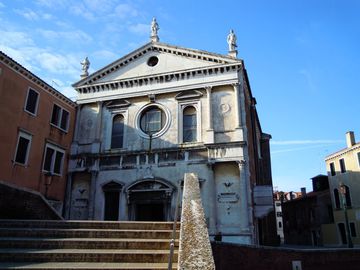

The insignificant location of this church, hidden somewhere on the edge of town, really does not do it justice. Not only is the church dedicated to one of the most important saints in the Christian martyrology, not only does it possess a magnificent pictorial cycle depicting all the crucial episodes from his life, but the church also contains the tomb of the cycle's creator, one of the three great Venetian painters of the 16th century, Paolo Veronese.
Sebastian was born in Milan in 256 AD. He was appointed captain of the Praetorian Guard under Emperor Diocletian, who was unaware that Sebastian had already converted to Christianity. When people in the capital began refusing to sacrifice to the Roman gods and were being imprisoned, Sebastian started liberating them and even converting their pagan parents. He had been successful on many accounts before Diocletian finally found out and ordered Sebastian to be shot at with arrows. The Christian was tied to a stake in front of a squad of archers. However, after his execution, the widow of the emperor's chamberlain found him and saw that he was still alive. Sebastian continued criticizing Diocletian and propagating the Christian faith. It was then that the emperor had him arrested a second time and made sure that this time he would be beaten until he died. Sebastian's remains lie in the Church of San Sebastiano Fuori Le Mura in Rome.
Veronese's work colorfully brings back to life the most handsome saint ever to be martyred. In fact, in his novel "Death in Venice" Thomas Mann says that St. Sebastian is a supreme emblem of Apollonian beauty. It is perhaps thanks to this controversial novel that St. Sebastian gained a large following among the homosexual community in Europe and beyond. The canvases dedicated to the saint can be found behind the choir. The paintings on the ceiling, instead, depict scenes from the Book of Esther, one of the books from the Old Testament, while the organ doors contain three paintings from the life of Jesus Christ.
Paolo Veronese's real name was Paolo Caliari. He was born in 1528 and changed his surname to Veronese in honor of his hometown Verona, which had been incorporated into the Venetian Republic in the 15th century. He trained with Verona's leading painter at the time, Francesco Caroto. Veronese developed a particular approach to color, skillfully having it shine on the canvas. His talent was noticed by the Giustinians, an influential Venetian family who in 1551 asked him to paint the altarpiece for their chapel in the Church of San Francesco della Vigna. It became his first work in Venice. Before moving to the lagoon two years later, Veronese worked in Treviso and in Mantua. His first state commission came from the Council of Ten, the committee responsible for government and public security. He painted the dim and dingy ceiling of their chamber in the Doge's Palace. It was this fresco that gained Veronese the admiration of Venice's greatest painter, Titian Vercelli, and established Veronese as a master of the color scheme.
In 1556 Veronese was commissioned with the first of his monumental banquet scenes, the Feast in the House of Simon, for the Villa Barbaro in Maser, just outside of Venice. It was in this villa that the painter first collaborated with the renowned architect, Andrea Palladio, whose private villas were popping up all over the Veneto mainland. Veronese's next banquet scene was the Wedding at Cana, which was executed for the San Giorgio Maggiore Monastery, also in collaboration with Palladio.
Veronese's fame had become immense. He was receiving commissions from all over northern Italy. But in 1573, upon finishing the enormous Last Supper for the Church of Santi Giovanni e Paolo in Venice, Veronese was summoned by the Inquisition to explain why in such a serious episode from the Gospels he included dwarfs, drunkards, German soldiers and a variety of exotic animals. Veronese replied that he did not intend to be irreverent or offensive and that, to quote him, "we painters take the same liberties as poets and madmen." Instead of repainting the work, as he was ordered, Veronese simply changed the title. He called it the Feast in the House of Levi, a decision that had the support of the Venetian nobility. Today the painting hangs in Venice's Gallerie dell'Accademia.
Veronese died in 1588 and was buried in the Church of San Sebastiano by the left wall right before the presbytery. The church itself was erected in the first half of the 16th century by Antonio Abbondi, on the remains of an earlier church that had stood on the spot since the end of the 14th century and that was called Santa Maria Full of Grace and Justice. In the 15th century, after a plague had taken thousands of Venetian lives, that original church was renamed in honor of St. Sebastian, who, besides being a patron of archers, soldiers and athletes, is also a protector against the plague. On the apex of the façade we can see the saint looking out toward the lagoon, guarding the city from any potential pestilence.
The church's interior has a single-nave layout preceded by an atrium and a raised choir and a cupola that rises over the presbytery. Inside we can also find paintings by Veronese's rivals Titian and Tintoretto, as well as sculptures by Jacopo Sansovino and Alessandro Vittoria.